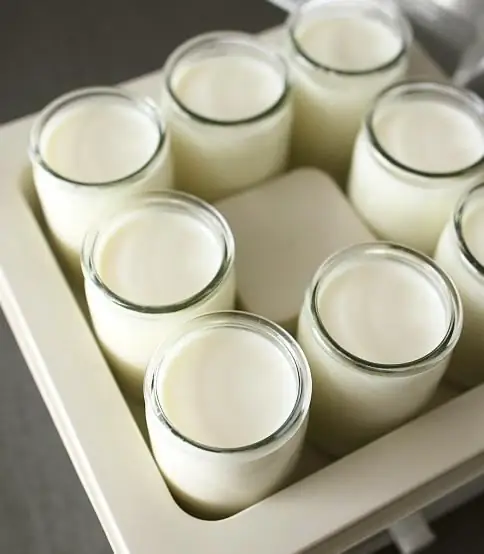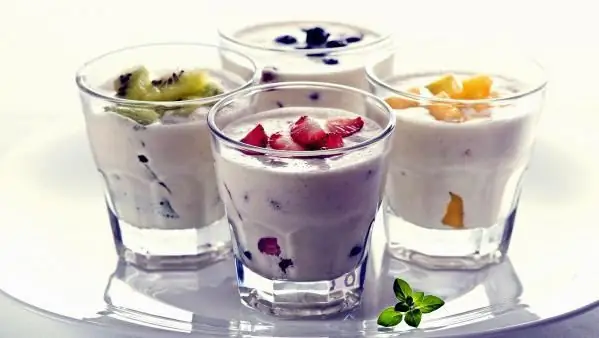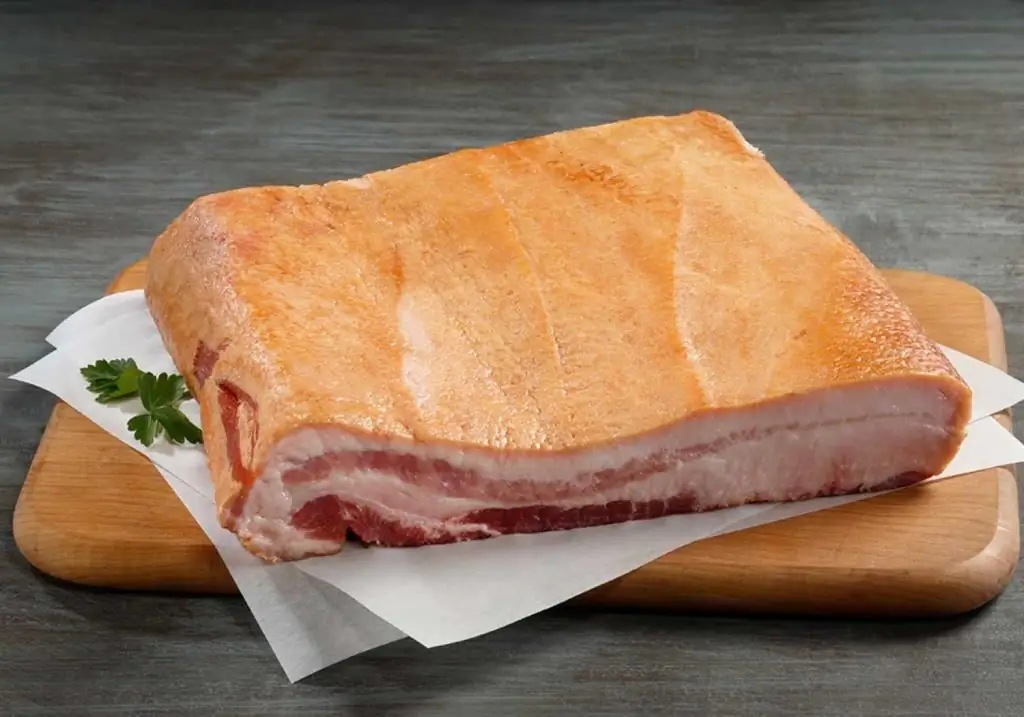2026 Author: Isabella Gilson | [email protected]. Last modified: 2025-01-23 12:50:31
To make low-fat yogurt, you should purchase fresh or pasteurized milk with a minimum fat content. It is worth noting that today there are a great many options for preparing such a delicacy. It is made using a yogurt maker, microwave, multicooker and other devices. But in this article, we decided to consider the easiest and fastest way that even a novice cook can use.

How to make low fat yogurt?
This question is not as relevant today as it was several decades ago. After all, to purchase such a tasty and sweet product, you just need to go to the store. But not all yogurts sold in supermarkets are good for our body. That is why some housewives still cook such a delicacy at home.
Let's look at what products you need to purchase in order tomake your own low-fat yogurt:
- fresh or pasteurized milk of minimum fat content (up to 1.5%) - 1 l;
- skimmed milk powder - ¼ cup;
- sand sugar (for "feeding" lactic acid bacteria) - 1 large spoon;
- fine s alt - a pinch;
- natural yoghurt with live cultures (no additives or colors) - 2 full large spoons (you can also use freeze-dried dry sourdough).
Preparing the foundation
Homemade fat-free yogurt is made in three steps. First you need to prepare the base. To do this, pour pasteurized milk into a metal container and gradually heat it up to a temperature of 45 ° C. If you are using a fresh drink, it is recommended that you first bring it to a boil, remove the film, and only then cool it to the figures mentioned. This should be done in cold water, lowering the bottom of the pan into it and stirring the contents thoroughly. It is also advisable to add ¼ cup of skimmed milk powder to such a drink. It will make the yogurt thicker, tastier and more nutritious.

Adding starter
While the boiled milk is cooling, the starter should be warmed to room temperature. To do this, it only needs to be taken out of the refrigerator and kept indoors for several hours. Next, warm yogurt, fat-free or dry lyophilized bacteria in a bottle, should be put into milk and mixed thoroughly (you can use a mixer).
Final stage -keeping warm
After the basis for the future delicacy is completely ready, it should be poured into a three-liter jar and loosely closed with a glass lid. Next, the container with the mixture needs to be wrapped in a cotton blanket and placed near any heat source. For example, in winter, a jar of milk mass can be placed near the battery or poured into an ordinary thermos. The main thing at the same time is to remember that natural fat-free yogurt must be kept at a temperature not higher than 50 and not lower than 30 ° С.

After 4-7 hours you should have a product that has the consistency of custard, but with a cheesy smell and a little greenish or yellowish liquid on the surface. This is exactly the mass that we need. It is worth noting that the longer fat-free yogurt is kept warm and ripened, the thicker and tastier it will become. In the process of creating such a product, it is extremely important not to move the container with the milk formula, as this significantly reduces the speed of its thickening.
Proper serving
After the yogurt has thickened and is completely ready, it should be placed directly in a glass jar in the refrigerator, where it can be stored for up to two weeks. It is recommended to serve such a drink to the table along with granulated sugar and berries. If desired, you can add a couple of spoons of liquid honey, as well as a pinch of cinnamon to this delicacy.

Helpful tips
If youit is necessary to use some homemade yogurt as a starter, then it is advisable to do this during the first 5-8 days, while the lactic acid bacteria are viable. In addition, whey that has formed on the surface of the product, which has a greenish-yellow tint, should be drained immediately or used for kneading dough, preparing salads, etc.
As a rule, manufacturers add various thickeners (starch, pectin, gelatin, etc.) to many yogurts sold in supermarkets. That is why you should not be surprised and worry in vain if the dairy product you cooked turned out to be watery.
Recommended:
Is it possible for a breastfeeding mother to have fat: the benefits and harms of fat during breastfeeding

While breastfeeding, a woman should take full responsibility for her diet. After all, everything that she uses, enters the body of her baby. Due to the fact that he has an immature digestive system, the most common food can cause negative reactions. Many women ask if it is possible for breastfeeding mothers to eat fat. The article will discuss the benefits of the product for the baby's body, the features of its reception, the advantages and disadvantages
Yogurt maker: recipes. How to make yogurt in a yogurt maker: recipes

It is quite difficult to maintain your he alth in the norm, if you do not follow the correct regimen and diet. That is why experts recommend using real fermented milk products every day, which contribute to the excellent functioning of the digestive tract, increase the body's immunity, as well as strengthen teeth and bones
Yogurt: calorie content of drinking yogurt, natural, homemade, Miracle yogurt

Yogurt is one of the most useful and nutritious types of fermented milk products. Its difference from kefir or, say, curdled milk lies in the unique way of sourdough. Yogurt, which is relatively low in calories, has many healing properties
Thermostatic yogurt - what is it? How to make thermostatic yogurt? Thermostatic yogurt: benefits, reviews

Dairy products are very useful for the human body. In the article, we will focus on how to cook thermostatic yogurt at home, what it is. We will also offer several simple recipes for breakfast and desserts
From fat get fat or not? Calorie content, benefits and harms of the product

For hundreds of years, salo has been one of the most popular dishes in Russia and other countries. This food was consumed in combination with bread, stewed and fried other foods on it. And today this dish is in great demand. However, many modern people argue that the presence of such food in the diet leads to the accumulation of bad cholesterol in the body, contributes to weight gain. The answer to the question of whether they get fat from fat or not is ambiguous

